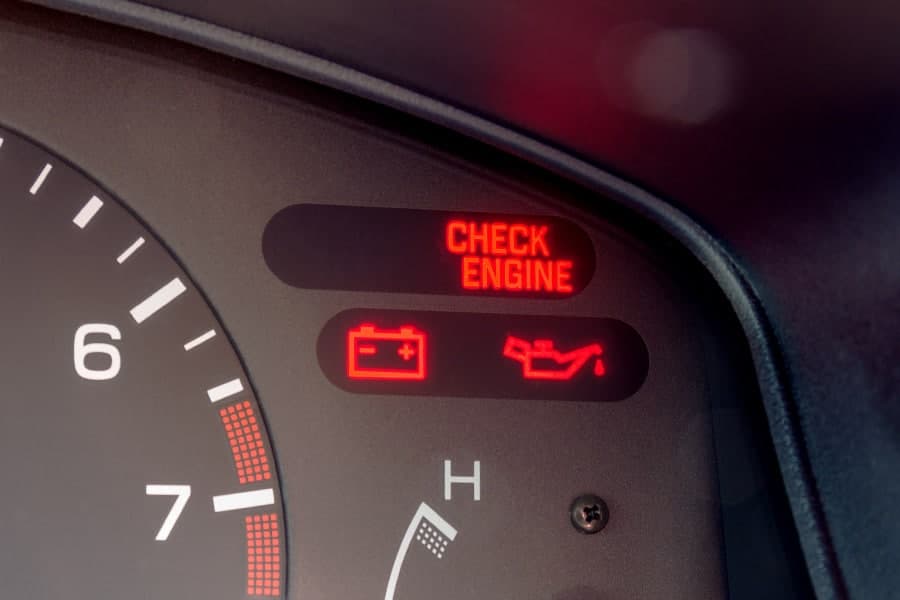Have you ever wondered, “Why does a car’s check engine light come on?” It’s a common question, and there can be various reasons for it. Understanding what the check engine light means is crucial; think of it as your vehicle’s instinct signaling that something is amiss.
In simple terms, the check engine light Monroe illuminates when your car’s internal system detects an issue with the engine or transmission. The causes for a check engine light can range from a loose gas cap to more severe problems like a faulty catalytic converter, or even a sign of internal engine failure. Ignoring this warning can transform a potentially simple repair into a costly and time-consuming ordeal.
Let’s explore why this happens and what to do if you see the check engine light on.
What Does the Check Engine Light Monroe Indicate?
The check engine light, often called the malfunction indicator light, typically signals that something is awry with your vehicle’s engine. However, the triggers for this light can vary widely, from a simple loose gas cap to a more complex issue like a faulty catalytic converter. Additionally, the cause of the light can differ based on your vehicle’s year, make, and model. In essence, without diagnostic work, it’s challenging to pinpoint why the engine light is activated.
So, how do you determine the urgency of the situation? Examining the warning light can help gauge the severity of the problem. There are two ways the check engine light might appear:
- Solid Yellow/Amber Light: This suggests a less pressing issue.
- Red or Flashing Light: This indicates a more urgent concern.
What To Do In Case of an Illuminated Check Engine Light?
When you spot the check engine light illuminated, pay attention to how your vehicle is performing. Is there an obvious issue? If so, it’s advisable to redirect yourself to the nearest mechanic for a prompt car inspection. However, if your car seems to be operating normally, you can perform a few checks before seeking professional assistance.
A loose or damaged gas cap is one of the most common culprits behind a lit check engine light. Ensuring your gas cap is securely fastened and in good condition can prevent this issue.
Using low-quality or incorrect gasoline is another potential trigger for the check engine light. If your vehicle requires premium gas with an octane rating of 91 to 94, using regular gas with an octane level of 87 can lead to engine problems. However, a professional can safely resolve this issue by draining your gas tank. If you need to drive until the tank is nearly empty, it’s generally not a cause for significant concern unless your car exhibits signs of overheating or poor engine performance.
If you suspect a cause other than the gas cap or fuel quality, the most reliable way to diagnose the issue is by reading the diagnostic code stored in your car’s internal system. If you have experience working with vehicles, you can perform this task at home using an OBD-II scanner. Alternatively, you can visit your local service station, where a skilled mechanic can read the diagnostic code and recommend the appropriate course of action.
Strong Reasons Why Your Check Engine Light Might Illuminate
- Engine Issues: The check engine light can illuminate due to various engine problems, many of which can impact fuel economy. Examples include:
- Extremely low oil pressure, often indicated by the engine oil light, can trigger the check engine light.
- Continuous high-speed driving or frequent heavy towing can strain the engine, causing the check engine light to flash.
- An engine misfire can also lead to the check engine light blinking.
- Transmission Issues: Since the transmission plays a crucial role in managing engine power and delivering it to the wheels, a transmission problem, such as slipping, can result in poor fuel efficiency. If the control module detects such an issue, it will trigger the service engine light.
- Defective Emissions Equipment: Modern vehicles incorporate emissions systems like exhaust gas recirculation, catalytic converters, and evaporative emissions systems to reduce tailpipe emissions and enhance fuel economy. Minor problems like a loose gas cap or faulty fuel cap can cause the check engine light to come on. A damaged gas cap allows fuel vapors to escape, leading to decreased fuel economy. Similarly, a malfunctioning canister purge valve can also trigger the check engine light Monroe by allowing fuel vapors to escape.
- Ignition System Troubles: The ignition system is vital for igniting the air-fuel mixture in the engine. Issues like a worn-out ignition coil or faulty spark plug wires can activate the check engine light. A malfunctioning spark plug can hinder engine startup or result in sudden shutdowns, potentially causing engine misfires if left unattended.
- Malfunctioning Modules and Sensors: Your engine’s control unit relies on various sensors for optimal performance. Problems with sensors, such as malfunctioning oxygen sensors, clogged mass airflow sensors, or loose oxygen sensor wiring, can trigger the check engine light. For instance, a faulty oxygen sensor can cause your engine to consume more fuel than necessary, leading to decreased fuel efficiency.
- Overheating Due to Excessive Heat: If the engine coolant hasn’t been replaced regularly, it can cause wear and tear on the thermostat, potentially leading to overheating. In such cases, the check engine light will illuminate, and your dashboard’s temperature gauge will indicate overheating. It’s crucial to stop driving immediately if this occurs, as it may trigger the P0217 error code. Schedule an appointment with an auto repair professional promptly for a comprehensive diagnosis and resolution.
Ensure that your check engine light is never ignored, as addressing the underlying issue promptly can event further damage and maintain optimal fuel efficiency.
What Can Happen if You Ignore the Check Engine Light?
First, check whether your check engine light is simply illuminated or flashing. A flashing check engine light indicates a severe internal failure that requires immediate attention. However, in any case, ignoring the check engine light is not advisable. Driving with a non-flashing but illuminated check engine light Monroe can lead to reduced fuel economy and eventually result in more significant and costly repairs.
Since many vehicle systems are interconnected, a failure in one system can have a cascading effect on the performance of others. If you take your vehicle for a state inspection with an illuminated check engine light, it will fail the emissions test, jeopardizing your vehicle’s compliance.
Overall, to maintain the integrity of your vehicle, it’s essential to address the check engine light promptly. At EG Auto Center, we offer check engine light Monroe diagnostics and fluid exchange services Monroe. Our technicians retrieve trouble codes and thoroughly investigate the underlying problem before commencing repairs. If your check engine light is on, don’t delay. Contact us right away by calling us at (732) 329-6300 or using our convenient online appointment form to schedule an appointment.

